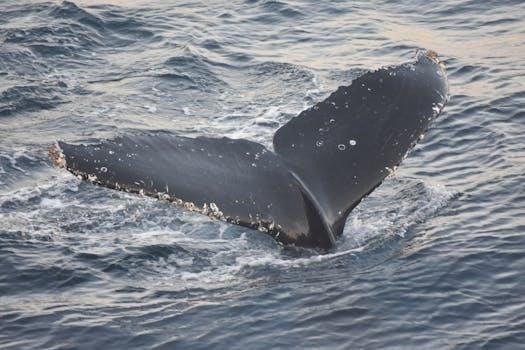ocean to pdf
- by blaise

This guide explores the vital process of converting ocean data into PDF format. It covers the importance‚ benefits‚ methods‚ and real-world applications. The PDF format is key for sharing and archiving oceanographic findings.
Understanding the Need for Ocean Data in PDF Format
Ocean data‚ often complex and multifaceted‚ requires a universally accessible format for effective sharing and analysis. The PDF format addresses this need by providing a standardized‚ platform-independent way to present information. Unlike raw data formats‚ PDFs maintain consistent formatting and layout across different devices and operating systems. This is crucial for ensuring that scientific findings‚ reports‚ and educational materials related to ocean studies are viewed as intended by all users. PDF files also offer capabilities for embedding images‚ charts‚ and other visual elements‚ enhancing the clarity and impact of the information. The use of PDF aids in accessibility‚ particularly for those who need a structured way to review detailed ocean data.

Methods for Converting Ocean Data to PDF
Several methods exist for converting ocean data to PDF‚ encompassing software applications‚ online tools‚ and programming solutions. These approaches cater to diverse needs and technical capabilities.
Software Applications for Data Conversion
Numerous software applications facilitate the conversion of diverse data formats‚ including those used in oceanography‚ into PDF documents. These applications often provide advanced features like batch conversion‚ allowing users to process large datasets efficiently. They frequently offer customization options such as page size‚ margins‚ and orientation‚ ensuring high-quality PDF output. Some software may also include optical character recognition (OCR) capabilities‚ which enable conversion of images and scanned documents into editable text within the PDF. These tools cater to both basic and advanced users‚ providing a range of functionalities for comprehensive data conversion from various formats to PDF.
Online Tools for PDF Conversion
Online tools offer a convenient way to convert various file types to PDF‚ often without requiring any software installations. These platforms typically support a wide range of input formats‚ including documents‚ images‚ and even web pages‚ making them versatile for ocean data conversion needs. Users can often adjust settings like page size and orientation to achieve the desired PDF output. Many online converters provide additional functionalities‚ such as merging multiple files into a single PDF or compressing file sizes for easier sharing. These tools are generally user-friendly‚ offering a quick and accessible solution for converting data into PDF format.
Programming Solutions for Automated Conversion
For more complex or repetitive ocean data conversion tasks‚ programming solutions provide a powerful and efficient approach. Utilizing libraries and APIs in languages like Python or JavaScript‚ developers can create custom scripts to automate the process of converting data to PDF. These solutions offer greater flexibility and control‚ enabling users to handle large datasets‚ apply specific formatting requirements‚ and integrate the conversion process directly into existing workflows. Automated conversion also reduces manual effort and the potential for human error‚ ensuring accuracy and consistency in the output files. This method is particularly beneficial for research and monitoring projects that require frequent PDF generation.

Benefits of Converting Ocean Data to PDF
Converting ocean data to PDF enhances sharing and accessibility. It also improves data preservation and archiving. PDF ensures data integrity‚ making it ideal for long-term use in research.
Improved Data Sharing and Accessibility
The PDF format significantly improves the sharing of ocean data. Unlike specialized data formats‚ PDFs can be opened on virtually any device. This universal accessibility facilitates collaboration among researchers‚ policymakers‚ and the public‚ regardless of their software. Converting to PDF ensures that complex data visualizations and reports remain consistent across different platforms; It also simplifies distribution via email or online platforms‚ allowing stakeholders to easily access information. This streamlined access promotes transparency and informed decision-making in ocean-related fields. The ubiquitous nature of PDF makes data widely usable and understandable. It breaks down technical barriers for efficient communication.
Enhanced Data Preservation and Archiving
Converting ocean data to PDF enhances preservation and archiving. The PDF format ensures data integrity over long periods‚ protecting it from software obsolescence. Unlike proprietary formats‚ PDFs are designed for long-term access. This makes them ideal for archiving important oceanographic studies and research findings. The ability to embed fonts and images ensures that document fidelity is maintained. This is crucial for future reference. PDFs also provide a static view of the data at the time of conversion. This eliminates the risk of changes due to format or software updates. The format promotes consistency and allows future generations to access historical ocean data. This format is essential for scientific record-keeping.

Considerations for Accurate PDF Conversion
Accurate PDF conversion requires careful attention to data integrity. Maintaining the original data’s accuracy is paramount. File size optimization is essential for efficient storage and sharing.
Maintaining Data Integrity During Conversion
Maintaining data integrity during ocean data conversion to PDF is crucial for reliable research and reporting. The conversion process should not alter the original values‚ units‚ or spatial relationships of the data. This requires careful selection of conversion tools and methods that preserve the accuracy of numerical values‚ textual annotations‚ and graphical representations. Using tools that allow for verification of converted data against the original data is advisable. The process must also ensure that metadata‚ such as timestamps and source information‚ are correctly transferred. Failure to maintain integrity can lead to misinterpretations‚ flawed analyses‚ and inaccurate conclusions‚ highlighting the importance of meticulous conversion practices.
File Size and Optimization for PDF
Managing file size and optimizing PDFs is essential when converting ocean data. Large PDF files can be cumbersome to share‚ store‚ and access‚ especially when dealing with complex datasets. Optimization involves reducing file size without compromising data quality. This can be achieved through techniques like image compression‚ downsampling‚ and removal of unnecessary elements. Selecting appropriate PDF settings‚ such as embedding only necessary fonts‚ can also help. Balancing file size and data detail requires careful consideration. Optimized PDFs facilitate easier distribution and faster loading times‚ enhancing the user experience. Effective optimization ensures that data remains accessible and usable without unnecessary storage demands.

Real-World Applications of Ocean Data in PDF
Ocean data in PDF format is used extensively in research publications‚ environmental reports‚ and educational materials. This format ensures data accessibility and facilitates data sharing in various fields.
Research and Scientific Publications
The use of PDF format is crucial for disseminating oceanographic research findings. Researchers often convert datasets‚ charts‚ and analysis results into PDF documents for publication in journals. This ensures consistent formatting and accessibility across various platforms‚ facilitating the review and sharing of scientific knowledge. PDF allows for the preservation of complex data visualizations‚ equations‚ and detailed descriptions‚ which are essential for scientific rigor. Furthermore‚ PDF enables researchers to include supplementary materials‚ like high-resolution images or detailed data tables‚ supporting transparency and repeatability in studies. It’s a standard format for scholarly communication within the ocean science community.
Environmental Monitoring and Reporting
Environmental agencies and organizations utilize PDF format for reporting on ocean conditions and pollution levels. Data collected from sensors‚ satellites‚ and on-site surveys are often compiled into PDF reports that are easily shared with stakeholders. PDF documents ensure that the data is presented consistently across different devices and operating systems. This uniformity is essential for effective communication of critical information‚ such as marine life population trends or plastic pollution concentrations. The PDF format facilitates the inclusion of maps‚ graphs‚ and detailed analysis‚ making it easy for decision-makers and the public to understand the state of the marine environment. It also serves as a reliable medium for archiving this important environmental data.
Educational Materials and Training
PDF is an ideal format for distributing educational materials related to oceanography. From textbooks and research papers to training manuals‚ the format ensures reliable access. Students and professionals worldwide can use PDF documents for learning about ocean processes‚ marine biology‚ and conservation. The format maintains the visual integrity of charts‚ diagrams‚ and images. This makes complex concepts more accessible and easier to understand. PDF’s compatibility across various devices allows students to access learning materials on computers‚ tablets‚ and smartphones. Furthermore‚ PDF documents are easily annotated‚ which supports interactive learning and the creation of personalized study guides. The portability and reliability of PDFs make them perfect for distance learning and training programs.
No related posts.
Transform your ocean of files into neat PDFs! Hot Sauce Hippie makes converting to PDF a breeze. Try it now and simplify your digital life!
Posted in PDF